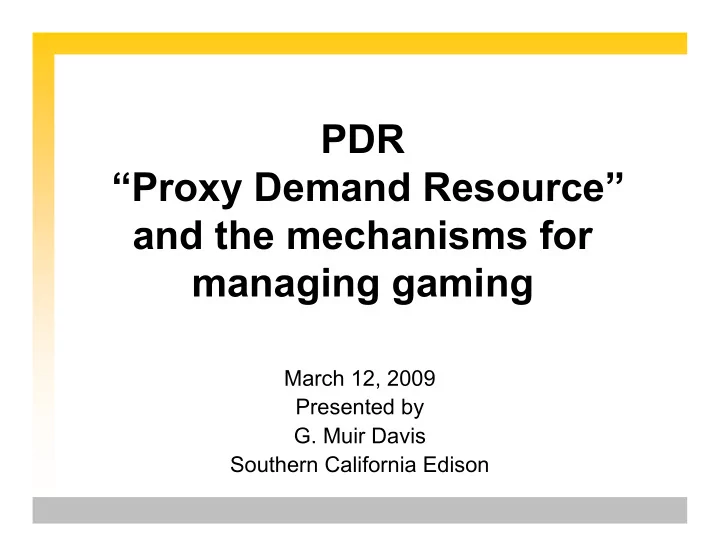

PDR “Proxy Demand Resource” and the mechanisms for managing gaming March 12, 2009 Presented by G. Muir Davis Southern California Edison
Agenda • LECG gaming concern – Buy at LAP, sell at CLAP – Selling load that is not there – Price taker – Availability • FERC requirement – Direct participation – Curtailment service providers – Load serving entities • PDR Elements for managing the risks – Bid and settle at the CLAP – Selling demand response capability – Baseline(s) – Bid threshold – Availability Page 2
LECG Gaming Issue LECG Gaming Issue Paraphrased LECG Concerns: The sixth major implementation issue identified with the MRTU market design is the risk of demand response as a “money machine.” Buying at the LAP price in the DAM and bidding the demand response resource at a low enough price to ensure it is dispatched nodally, earning the difference between the nodal price and the zonal price for doing nothing. A load’s demonstrated dispatch capability is presumably limited by its maximum energy consumption but it may be economic to inflate this if the spread between the LAP and nodal price is material over a large number of hours. Page 3
Gaming concerns Gaming concerns • DR captures difference between CLAP price and LAP price for doing nothing. • Low enough price to ensure dispatch means DR is a price taker. • Over a large number of hours • Dispatch capability may be inflated Page 4
LECG gaming concern LAP ($150) CLAP 1 CLAP 3 ($100) ($90) CLAP 2 ($200) $/MWh Money Machine = ($200 - $150) * X * (24 * 365) $0 MW X Page 5
FERC Requirement FERC Requirement • Direct participation in MRTU for demand response – Functional separation of load and curtailment services • Curtailment service providers – Independent from load serving entities – Provide demand response capability • Load serving entities – Independent from curtailment service providers – Bid “forecasted” load Page 6
PDR LAP ($150) • Bid and settle at the CLAP • Selling demand response CLAP 1 capability CLAP 3 ($100) ($90) – Baseline measures DR responsiveness CLAP 2 – Correlation between high loads ($200) and high prices – Cost of inflating baseline inhibits negative behavior $/MWh • Bid Price threshold – Significantly reduces the “price taking” potential – Supports baseline methodology • Availability – Current retail price response DR programs are • Monday through Friday $0 • Noon to 8:00 PM – This window of limited hours are supportive of strong correlation MW between loads and prices X Page 7
Summary • A good baseline will reduce gaming opportunity significantly. – They are commonly used to settle DR in both the retail and wholesale markets. – They can be designed to make gaming very expansive. – CPUC 2009-11 DR proceeding is looking at it in detail. • Price bid threshold will eliminate ability to participate as “Price taker” and reduce predictability of dispatch. • As visibility of PDR increases through baseline methodology price bids and hourly usage availability may be relaxed. Page 8
Recommend
More recommend